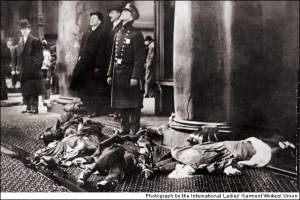Next Monday, September 7, will be celebrated as Labor Day in the United States (Labour Day in Canada) and thousands of people will hold picnics or parades and watch fireworks to celebrate the day. This day marks the end of summer and more people will worry about beating the traffic on their way to an event than about the state of labor in the country. That’s too bad because  there has been a lot of news recently that affects labor—the minimum wage has been raised in several California cities and in Seattle to $15 per hour; on the downside are the revelations recently published in the New York Times about how difficult it is to work at Amazon.com. Several commentators have used this article as the basis for condemning the tech industry in general for expecting longer hours and worse treatment than employees should accept. It seems clear that the situation for working people is a confused and contentious one. That’s nothing new.
there has been a lot of news recently that affects labor—the minimum wage has been raised in several California cities and in Seattle to $15 per hour; on the downside are the revelations recently published in the New York Times about how difficult it is to work at Amazon.com. Several commentators have used this article as the basis for condemning the tech industry in general for expecting longer hours and worse treatment than employees should accept. It seems clear that the situation for working people is a confused and contentious one. That’s nothing new.
The Labor Day holiday began during the 1880s, sponsored by labor unions as a way of forwarding their campaign to established the eight-hour day. There is still argument about whether it was Matthew Maguire or Peter McGuire who first proposed a day to honor labor. Both men were active union men and they were probably thinking of labor as representing primarily working men, but actually women have often been the people who benefitted most from the labor laws sponsored by unions. The eight-hour day was a step forward for women who worked in factories and mills. Over the years the 58-hour week has become the 40-hour week making it possible for women to work and yet have enough time to take care of their families.
During the early part of the 20th century, unions grew stronger helped by the strikes sponsored by women who worked in the garment trades. The establishment of the ILGWU (International Ladies Garment Workers Union) helped to make

women workers an integral part of the labor movement. Most of the workers in the garment industry in New York at that time were immigrant girls and women who were willing to strike to support their demands. Although the struggle to win recognition of the ILGWU was long and difficult, it convinced many women of the importance of the union movement. Woody Guthrie celebrated the women union supporters in his song “There Once Was a Union Maid”
Oh, you can’t scare me, I’m sticking to the union,
I’m sticking to the union, I’m sticking to the union.
Oh, you can’t scare me, I’m sticking to the union,
I’m sticking to the union ’til the day I die.
There aren’t many women working in garment factories in New York any more, or even in the United States. Instead, most of the women’s clothing used in America come from countries like China, Pakistan, and Bangladesh, where the union movement has never been powerful. We were reminded of that two years ago

in April of 2013 when the Rana Plaza building in Bangladesh collapsed killing more than 1,000 people, most of them young women workers. Just like the women killed in the terrible Triangle Shirtwaist Company fire in New York a hundred years earlier, these women were struggling to make a living while getting low wages and often being ordered to work in unsafe conditions.
The world stood by in horror as the month-long search for survivors continued. The newly-elected Pope Francis expressed the feelings of many when he pointed out that no one should have been working under the conditions at Rana Plaza. As reported by the Huffington Post, the Pope said:
A headline that really struck me on the day of the tragedy in Bangladesh was ‘Living on 38 euros a month’. That is what the people who died were being paid. This is called slave labour. Today in the world this slavery is being committed against something beautiful that God has given us – the capacity to create, to work, to have dignity. How many brothers and sisters find themselves in this situation! Not paying fairly, not giving a job because you are only looking at balance sheets, only looking at how to make a profit. That goes against God



